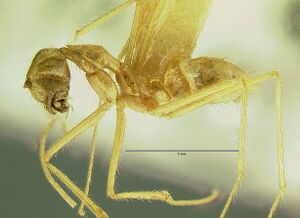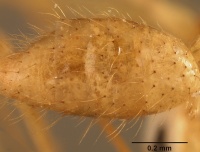Euprenolepis negrosensis
| Euprenolepis negrosensis | |
|---|---|

| |
| Scientific classification | |
| Kingdom: | Animalia |
| Phylum: | Arthropoda |
| Class: | Insecta |
| Order: | Hymenoptera |
| Family: | Formicidae |
| Subfamily: | Formicinae |
| Tribe: | Lasiini |
| Genus: | Euprenolepis |
| Species: | E. negrosensis |
| Binomial name | |
| Euprenolepis negrosensis (Wheeler, W.M., 1930) | |
Nothing is known about the biology of this species.
Identification
This species is easily distinguished from other species and is by far the most morphologically peculiar species in the genus. It has exceedingly long scapes, and an incredibly elongated, narrow body. Brown (1953) transferred this species to Euprenolepis based on the constriction of the mesosoma immediately behind the pronotum and the short labial and maxillary palps. As discussed under the genus diagnosis section, however, this placement remains problematic. To my knowledge this species has only been collected three times, and what is really needed are specimens that can be utilized for molecular analysis to confirm placement within Euprenolepis. Euprenolepis echinata has a similarly shaped pronotum and this may indicate a close relationship with E. negrosensis. Also as in E. negrosensis, E. echinata possesses particularly long erect setae, especially on the gaster. (Lapolla 2009)
Keys including this Species
Distribution
Known from Borneo (Sabah) and the Philippines.
Latitudinal Distribution Pattern
Latitudinal Range: 9.316667° to 5.66667°.
| North Temperate |
North Subtropical |
Tropical | South Subtropical |
South Temperate |
- Source: AntMaps
Distribution based on Regional Taxon Lists
Indo-Australian Region: Borneo, Indonesia, Malaysia, Philippines (type locality).
Distribution based on AntMaps
Distribution based on AntWeb specimens
Check data from AntWeb
Countries Occupied
| Number of countries occupied by this species based on AntWiki Regional Taxon Lists. In general, fewer countries occupied indicates a narrower range, while more countries indicates a more widespread species. |

|
Estimated Abundance
| Relative abundance based on number of AntMaps records per species (this species within the purple bar). Fewer records (to the left) indicates a less abundant/encountered species while more records (to the right) indicates more abundant/encountered species. |

|
Biology
|
Castes
  
| |
| . | Owned by Museum of Comparative Zoology. |

| |
| . | |
Nomenclature
The following information is derived from Barry Bolton's Online Catalogue of the Ants of the World.
- negrosensis. Chapmanella negrosensis Wheeler, W.M. 1930d: 42, fig. 1 (w.) PHILIPPINES. LaPolla, 2009: 11 (q.m.). Combination in Euprenolepis: Brown, 1953h: 6.
Unless otherwise noted the text for the remainder of this section is reported from the publication that includes the original description.
Description
Worker
LaPolla (2009) - Measurements (n=1): TL: 4.10; HW: 0.79; HL: 0.96; SL: 2.05; WL: 1.77; GL: 1.37. Indices: CI: 82; SI: 259.
Head brownish-yellow, with mandibles slightly darker; head much longer than broad. Head becomes slightly wider anteriorly. Head with abundant, long, thin erect setae, only sparse pubescence. Eyes very small, medially placed. Scapes exceptionally long, surpassing posterior margin by about the length of the funiculi; covered in abundant long, thin erect setae of varying lengths, with scattered pubescence. Mandibles similar to other Euprenolepis, but basal tooth is roughly quadriform relative to inner mandibular margin; masticatory margin with two small cuspids (one specimen, however, observed with an obtuse angle to the basal tooth as seen in other Euprenolepis). Mesosoma brownish-yellow, shiny, with legs the same color. Pronotum elongate and low as it rises toward mesonotum; mesosomal dorsum with many scattered thin, erect setae of various lengths. Mesosomal dorsum at about the same height across length except toward anterior pronotum and propodeum; mesonotal area elongated. Propodeum dorsally rounded with steep, but short declivity; propodeum dorsum with abundant thin, erect setae of various lengths. Procoxae especially elongated and thin. Petiole triangular, low, not higher than propodeum in lateral view; posterior face longer than anterior face; gaster brownish-yellow with thin, long erect setae and no pubescence underneath.
Queen
LaPolla (2009) - Measurements (n=1): TL: 8.7; HW: 1.2; HL: 1.3; SL: 2.3; WL: 2.8; GL: 4.6. Indices: CI: 95; SI: 184.
As in worker, with modifications expected for caste and the following differences: Overall color darker than in worker, with head and gastral dorsum brown. Entire body covered in a dense layer of pubescence; erect setae of varying lengths cover head, mesosoma notum, legs and gaster.
Male
LaPolla (2009) - Measurements (n=1): TL: 4.4; HW: 0.9; HL: 0.9; SL: 1.6; WL: 1.7; GL: 1.8. Indices: CI: 100; SI: 176.
Overall color brown to brownish-yellow, lighter brown on legs and funiculi; head darker than remainder of body; head about as long as broad. Cuticular surface dull, covered in a dense layer of appressed setae. Eyes large and bulging beyond head outline in full-frontal view; three prominent ocelli present. Scapes very long; scapes with many erect setae of varying length and a dense layer of pubescence. Clypeus roughly rectangular, with anterior margin emarginated. Mandible broad, with 4 teeth; all but apical tooth are weakly developed; apical tooth distinct, curves in toward body midline. Mesosoma enlarged to accommodate flight muscles; covered in a layer of appressed setae, with erect setae of varying lengths dorsally and on legs. Pronotum small and distinctly collar-like; mesonotum offset from pronotum at sulcus; mesonotum rises sharply above height of pronotum, giving pronotum a shelf-like appearance in lateral view. Mesonotum flat dorsally with many erect setae of varying lengths; propodeum indistinct from remainder of mesosoma, but with steep declivity. Petiole short, triangular, upright, with posterior face only slightly longer than anterior face. Gaster with a dense layer of pubescence and erect setae; terminalia especially setose. Parameres roughly triangular, turning slightly mesad posteriorly; long setae extend off of parameres. Cuspi small and tubular, reaching digiti dorsally; digiti weakly anvil-shaped, with poorly developed point directed ventrally. Volsellar lobes flat, slightly indented relative to digital margin; appressed setae cover surface.
Type Material
LaPolla (2009) - Holotype worker, PHILIPPINES: Dumaguete Negros Oriental, 7 April 1927 (J.W. Chapman) (Museum of Comparative Zoology) [examined].
References
- Boudinot, B.E., Borowiec, M.L., Prebus, M.M. 2022. Phylogeny, evolution, and classification of the ant genus Lasius, the tribe Lasiini and the subfamily Formicinae (Hymenoptera: Formicidae). Systematic Entomology 47, 113-151 (doi:10.1111/syen.12522).
- Brown, W. L., Jr. 1953h. Characters and synonymies among the genera of ants. Part II. Breviora 18: 1-8. (page 6, Combination in Euprenolepis)
- Cantone S. 2018. Winged Ants, The queen. Dichotomous key to genera of winged female ants in the World. The Wings of Ants: morphological and systematic relationships (self-published).
- LaPolla, J.S. 2009. Taxonomic revision of the Southeast Asian ant genus Euprenolepis. Zootaxa 2046: 1-25.
- Wheeler, W. M. 1930e. Two new genera of ants from Australia and the Philippines. Psyche (Camb.) 37: 41-47. (page 42, fig. 1 worker described)
References based on Global Ant Biodiversity Informatics
- LaPolla J. S. 2009. Taxonomic revision of the Southeast Asian ant genus Euprenolepis. Zootaxa 2046: 1-25.
- Lapolla, J. S.. "Taxonomic Revision of the Southeast Asian Ant Genus Euprenolepis." Zootaxa 2046 (2009): 1-25.
- Pfeiffer M.; Mezger, D.; Hosoishi, S.; Bakhtiar, E. Y.; Kohout, R. J. 2011. The Formicidae of Borneo (Insecta: Hymenoptera): a preliminary species list. Asian Myrmecology 4:9-58


